The Hai Van Pass is one of those travel experiences we’ll never forget. It features spectacular panoramic views, death defying roads and constantly evolving climates. We drove our own motorbikes from Hue to Hoi An and we want to help you experience the same electrifying rush we did.
In this guide we share our experience traversing the Hai Van Pass so you know exactly what to expect for your trip. It’s filled with our personal photos and tips to help you make the most of your time. Read more about us.
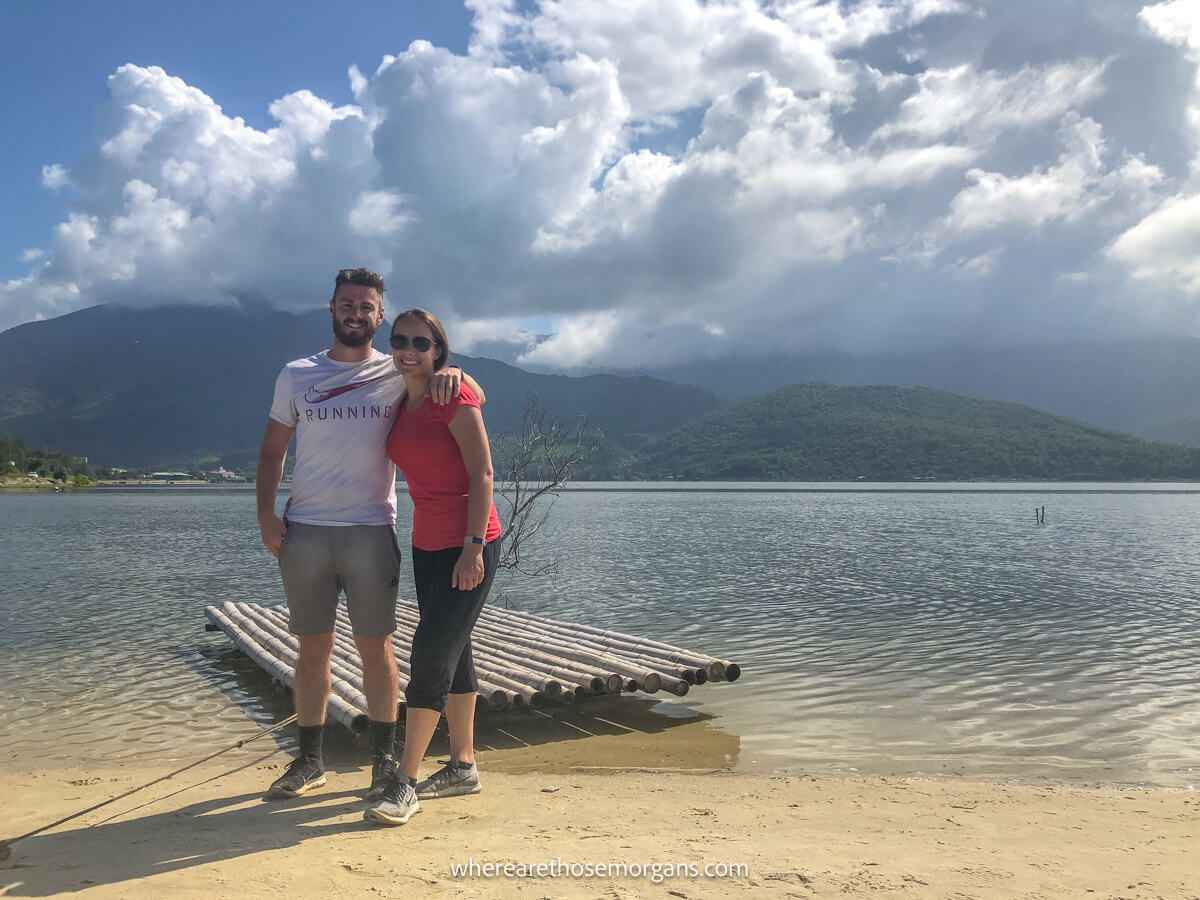
We drove the Hai Van Pass in October 2018 as part of our 18 month honeymoon around the world. This mountain pass become famous after it originally aired on the BBC as a Vietnam Top Gear Special in 2009. Clarkson et al waxed lyrical about the beauty of the Hai Van Pass and almost instantly the quiet coastal road blew up with tourists. So we knew we had to try it too.
There are many ways you can get over the mountain pass, but we decided to hire an individual guide and drive our own individual motorbikes. Since we both wanted to drive, we thought having a guide would make the trip so much easier because we wouldn’t have to focus on directions and they’d know exactly where to go. It was one of the best decisions we made in Vietnam. Okay, let’s begin!
Note: Our content is reader supported and contains affiliate links. If you make a purchase through one of these links, we may earn a small commission at no extra cost to you and it helps us keep this site running.
Hue To Hoi An Route Options
The total journey includes a distance of a 160km (about 100 miles) as you travel from Hue to Hoi An. But the actual Hai Van Pass is only 21km (about 13 miles). Overall, it’s about a 3 hour drive if you were to go at it with no breaks. However, our day lasted over 8 hours from door to door because we made several pit stops.
You can read more in our Da Nang to Hoi An transport guide, but there are 3 ways to cross the Hai Van Pass:
- Drive over the scenic pass reaching a summit of 496m (1,627 feet) of elevation. The best views of all options.
- Take the scenic train around the mountain, tightly hugging the coastline and entering a number of tunnels.
- Or drive directly straight underneath the pass through the longest tunnel in southeast Asia at 3.9 miles. It was built in 2005 to alleviate heavy road traffic and accidents on the snaking summit roads.
Personally, we really enjoyed driving over the pass ourselves and it’s been one of our favorite travel memories to date. If you choose to go this route, we’d highly recommend giving yourself a full day to see everything along the way.
We ended up booking our tour with Hue To Go Tours. This company was recommend by our hotel owner. It has high ratings on both Viator and TripAdvisor so we knew it’d be a good choice. Hue To Go Tours has offices in Hue, Da Nang and Hoi An which means you can start and end wherever it suits your schedule. They also transported our luggage to our final destination so we didn’t have to worry about our bags.
Other popular companies include Easy Rider, Hue Touring or Motorvina and you can’t really go wrong with either one. Traditional stops along the route include Tam Giang Lagoon, Elephant Springs, Lang Co Beach, Hai Van Pass summit and the Marble Mountains. Here are popular tour options:
Our total cost for a guide and two motorbikes was about US$ 80 per person. To respect his privacy, we haven’t included our guides personal contact information, but leave a comment at the end of this guide and we’ll be happy to pass it along to you in an email.
Now, let’s see what you can expect on your Hue to Hoi An motorbike tour:
1. Hotel Pick Up In Hue
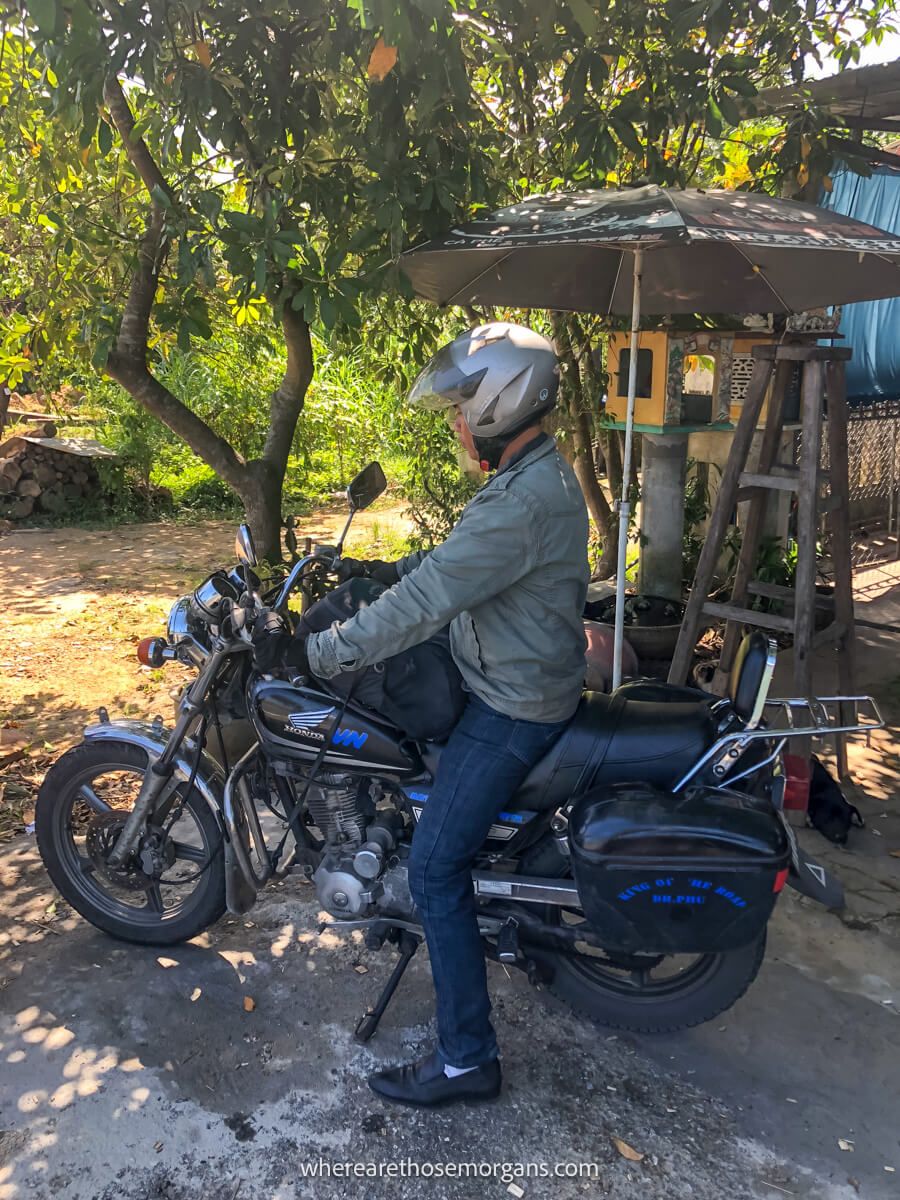
Our fabulous day began at 9:00am and our Osprey backpacks were picked up right at our Hue hotel to be driven to Hoi An. Then our automatic motorbikes were dropped off along with our wonderful guide, Dr. Phu. Kristen had a pink bike while Mark a white bike and we did the usual safety checks before hopping on.
We always recommend taking photographs of the bike exterior before you begin your ride. If you have any questions about something be sure to ask before you leave. Admittedly, we were both a little nervous. We had driven a little around Ninh Binh and Phong Nha on motorbike but nothing like a 160km slog on a busy highway. However, Phu was amazing from the word go, he made us feel at ease and relaxed immediately.
2. Gassing Up
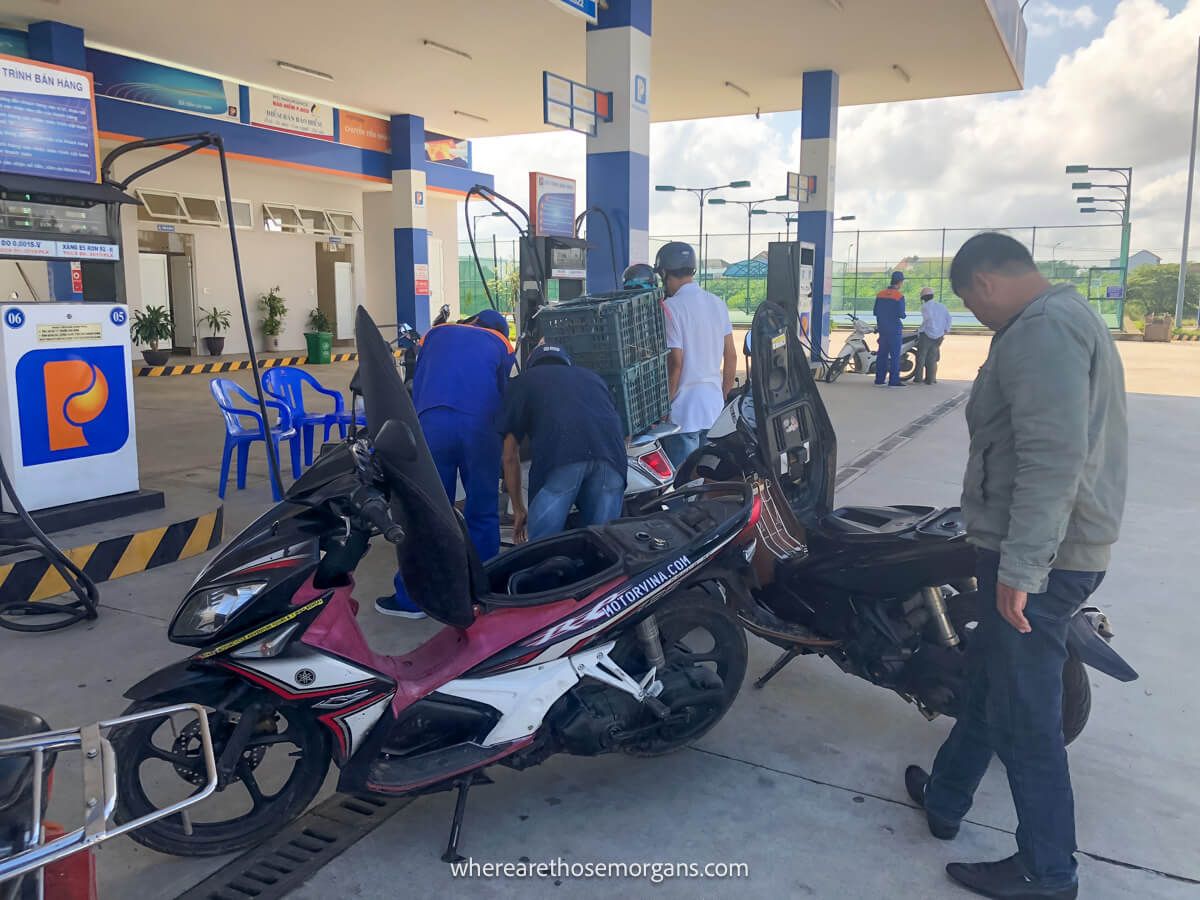
Getting out of Hue was interesting as we made a beeline for the quickest way to reach the rural countryside. Inevitably, there were a few near misses when it came to the traffic. Well, they felt like near misses to us, but they were standard operating procedures to the locals. But in a surprisingly short amount of time we got the hang of traffic patterns.
It’s actually organized chaos that somehow works.
The worst thing you can do is dilly dally about. You need to be confident and once you begin a maneuver, make sure you complete it quickly. Drivers will yield once you’re in motion, but if you’re stopped, pretty much anything goes. We enjoyed having Phu to help us properly navigate the roads. We felt safe with him and it was worth the money alone just for the extra layer of safety.
But we needed to fill up the tanks. Phu led us into a real gas station and handled the fueling up while we shared a laugh of relief at each other for getting through the traffic in Hue as our hearts were beating much quicker.
Travel Tip: Make sure you fill up a real gas station and avoid the people try to sell bottles of gas on the side of the road because who knows what they’re actually selling. Save yourself that drama, trust us.
3. Quaint Rural Fishing Villages
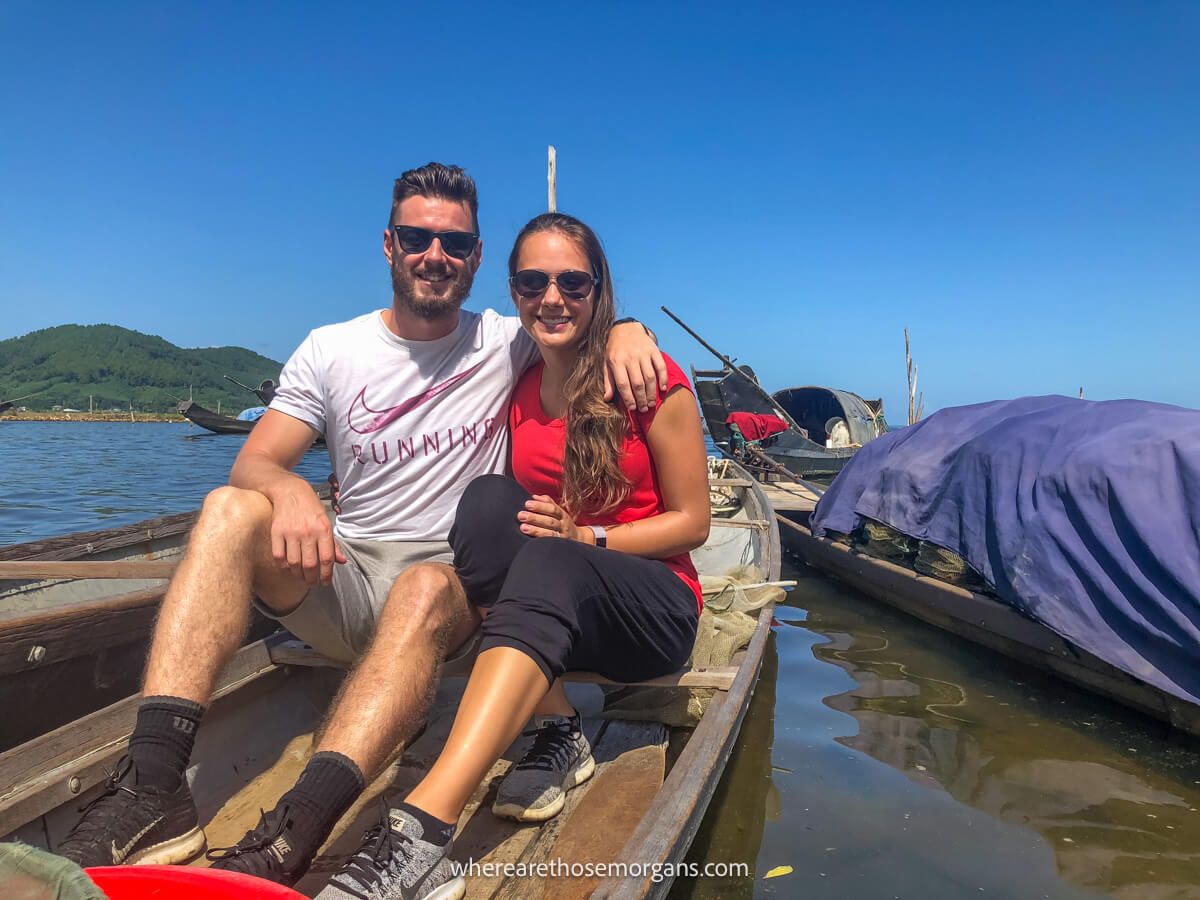
Full of fuel and newly found confidence, we followed Phu down some narrow dirt roads cutting through waterlogged rice paddies. Swerving left and right alongside fishing lakes and through rural villages. We began to relax as we were really getting the hang of this.
Now, in place of motorbikes as potential hazards, we had to look out for loose chickens, children and rogue goats. We stopped to admire some large straw structures with chicken coops inside. We also met a woman catching snails and she showed us her lucky technique.
As we continued, we passed an ornate family temple decorated with dragons, paintings and stunning colors. Phu told us it was built by a local wealthy family who now live in New York. The countryside was extremely peaceful and we never knew what was around the corner.
4. Elephant Springs
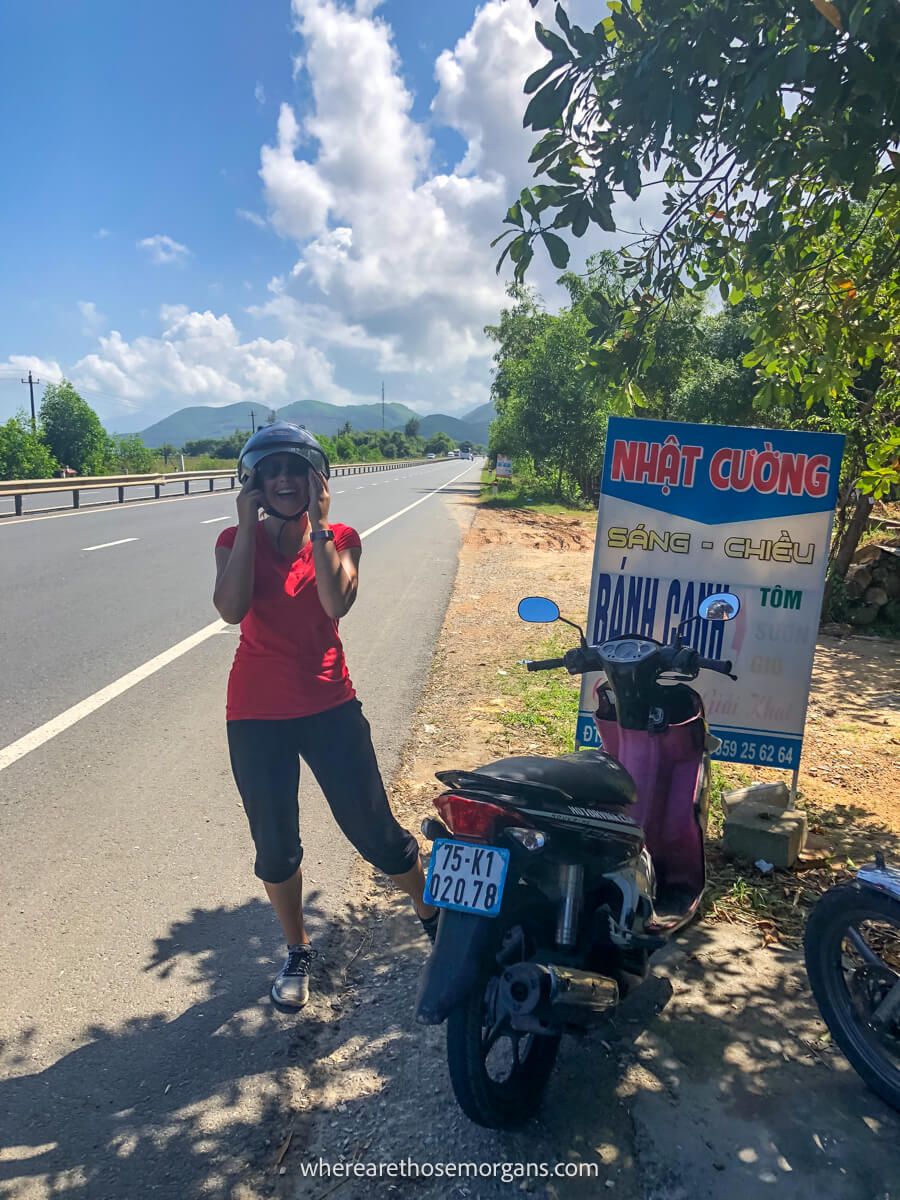
We stopped at a restaurant for a refreshing ice cold drink after a fairly long stretch of straight highway. We’d been cruising at a pretty good speed to cover some ground so we were happy for the break. Thunderous trucks howled by less than a meter from our parked motorbikes on the roadside in the makeshift parking lot.
After our cold drink, we drove a short while until we pulled off the main road and followed a poorly maintained dirt path to Elephant Springs. There was a barrier crossing the track with an entrance fee required. We gave Phu 2,000 VND each to pay for our motorbike parking and he handled the rest.
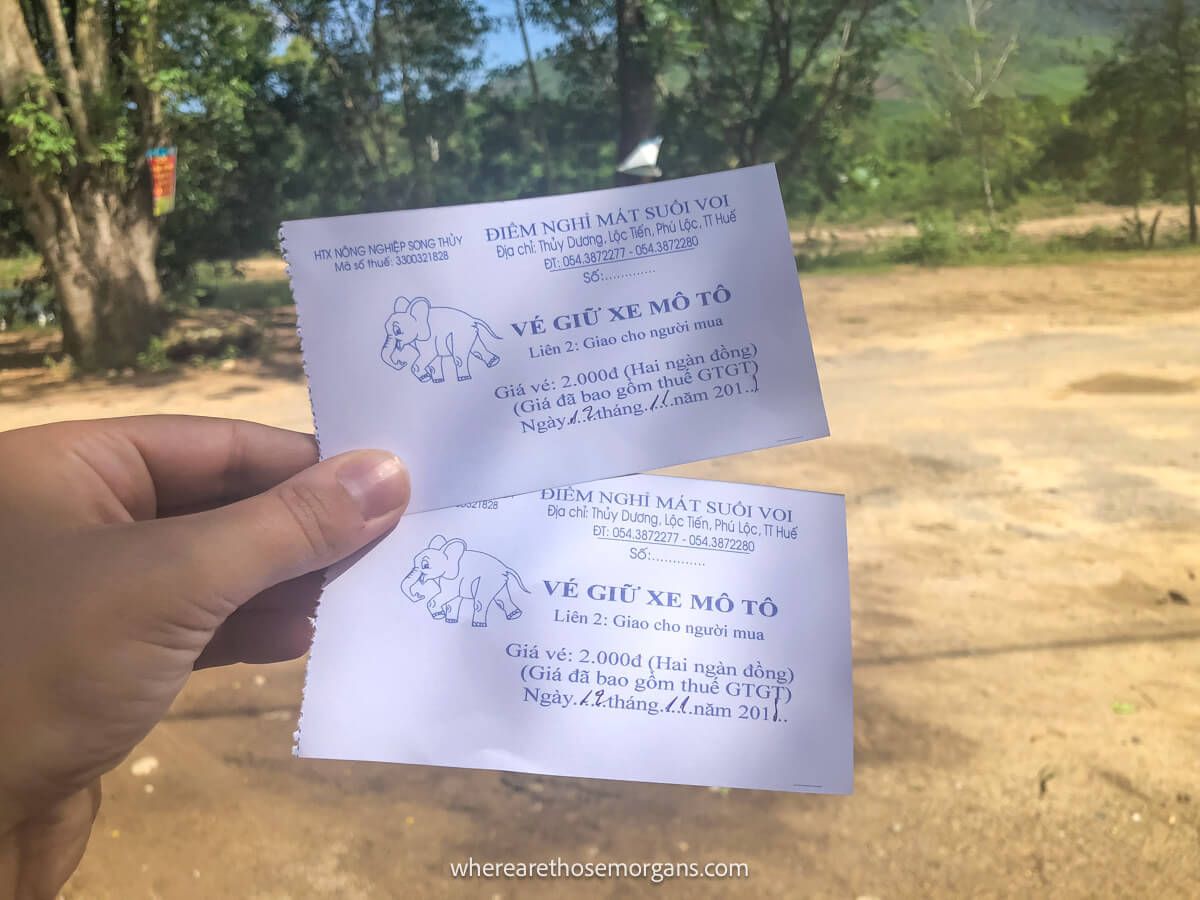
Personally, we thought Elephant Springs is nothing to shout home about but you’ll be ecstatic when you get to jump in the plunge pool area to cool off. Other tourists were submerged in the water trying to escape the inhospitable baking sun.
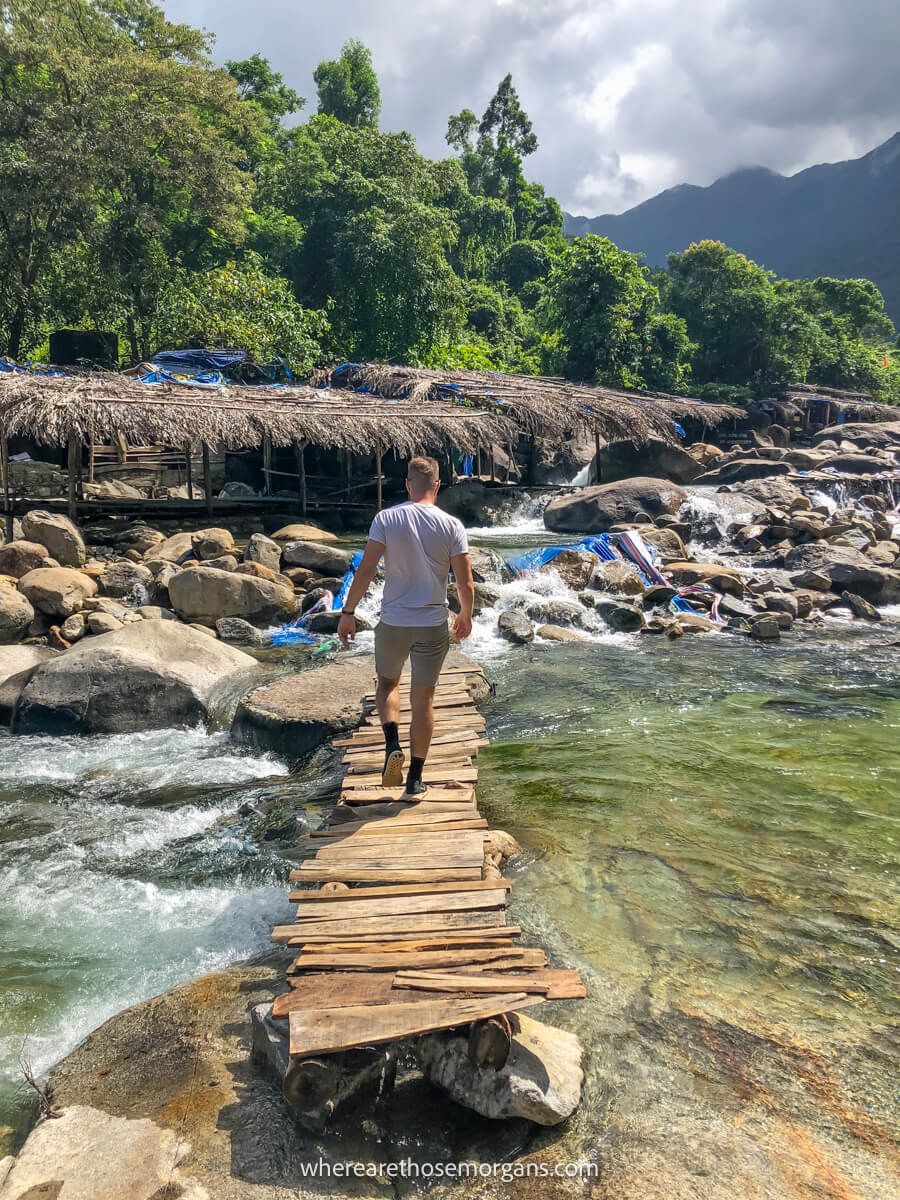
Before jumping in, we walked up some wooden boardwalks and over boulders to check the area out. Phu also took a few photos of us on elephant rock, which obviously had been man made using wrought iron bars. But after a few photos, we both enjoyed jumping in to cool off from the heat and humidity.
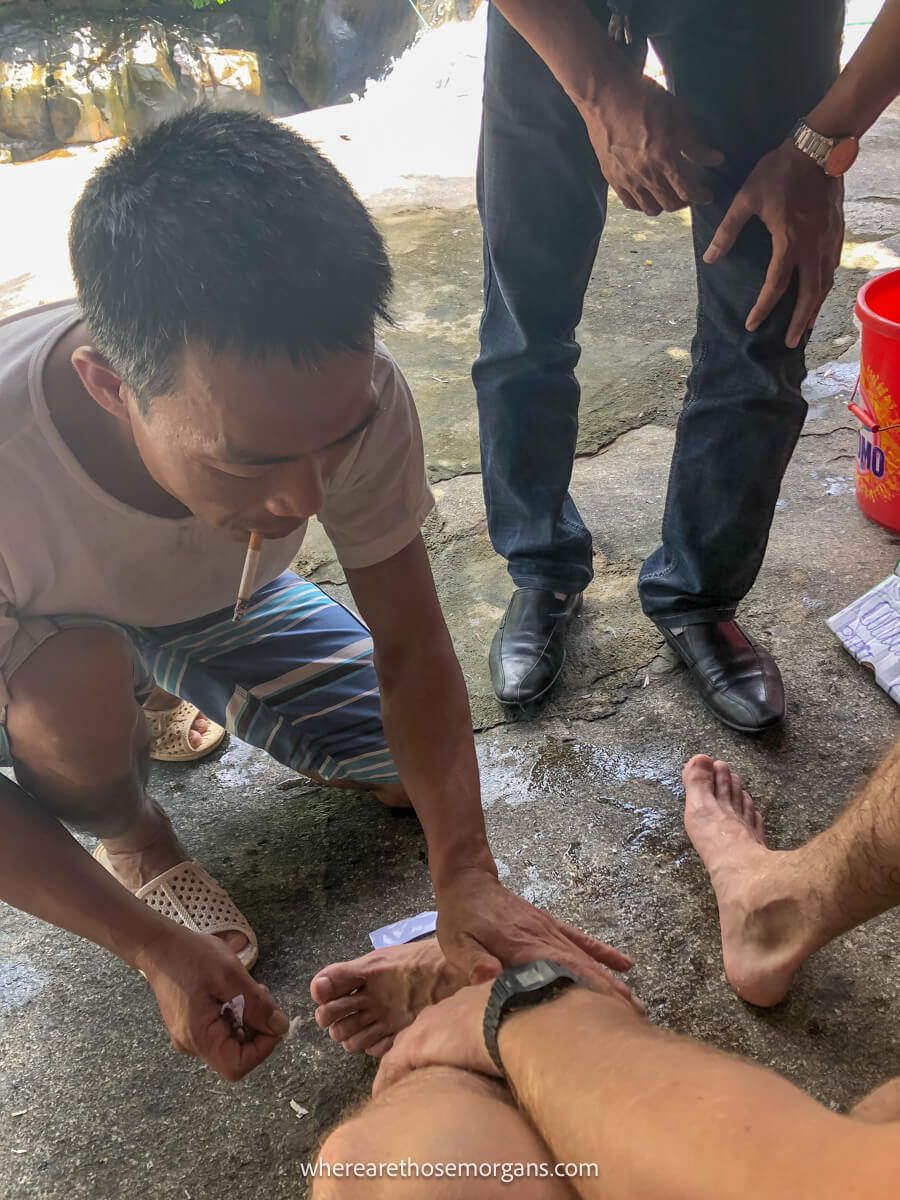
After swimming against the strong river current and walking around a bit, there’s not much else to do here. Except of course if you discover you have a leech on your leg. Mark had to call in the cavalry, aka the guy lighting his cigarette in one hand and lighting the leech on Mark’s leg in the other.
There were no screams, we promise. Phu of course oversaw the entire de-leaching process. But the moral of the story here is to check for leeches if you decide to take a dip in Elephant Springs. Or anywhere else in Vietnam for that matter.
5. Lang Co Beach
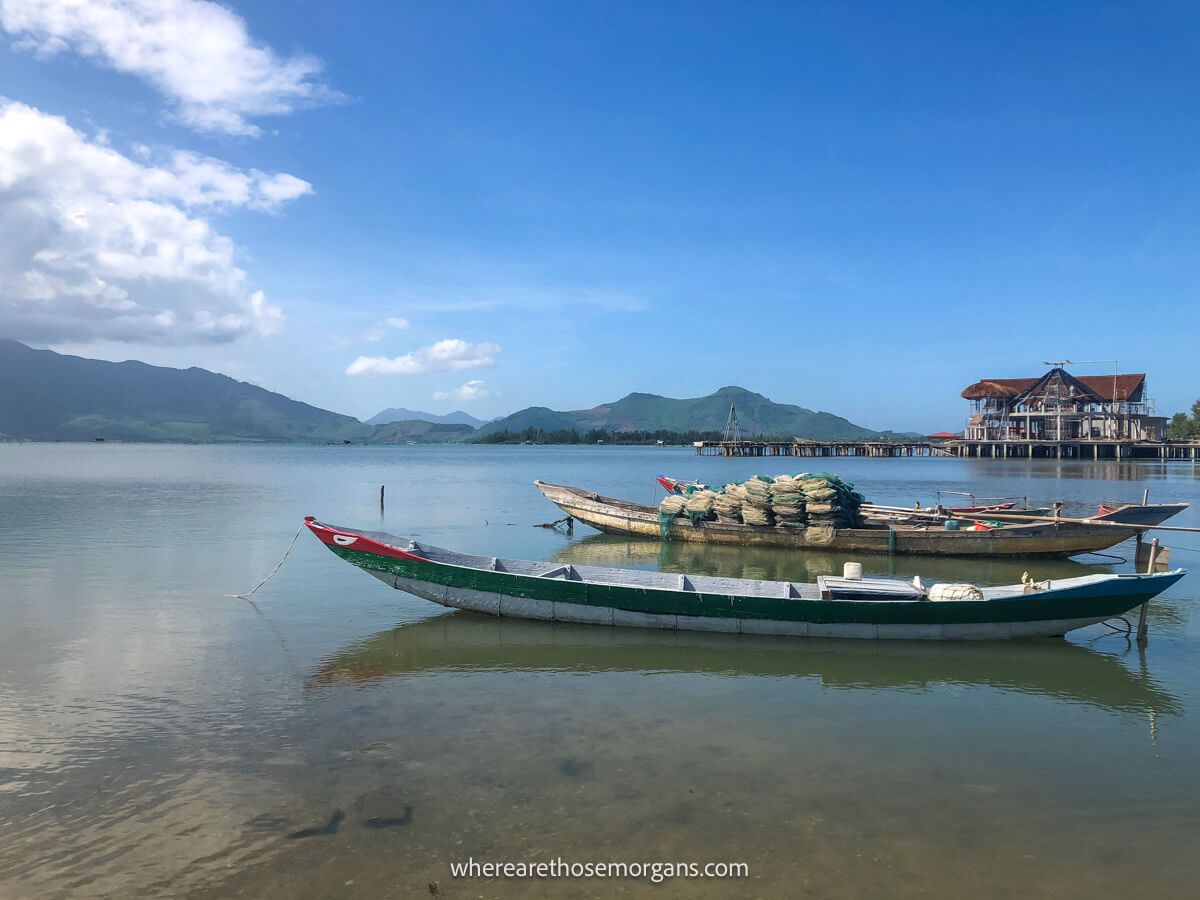
Not far from Elephant Springs is Lang Co beach, which is one of the prettiest areas of the day. We were hungry but before stopping for lunch we drove along the narrow spit of land separating the sea from a small lagoon. Around a dozen beachside restaurants made of wood sitting on stilts provided an extremely serene atmosphere.
There were some super photogenic spots that were completely unexpected. Be sure to look out for wooden rafts, leafless tree branches rising out of the still water and lifeless wooden boats if you want some great photos.
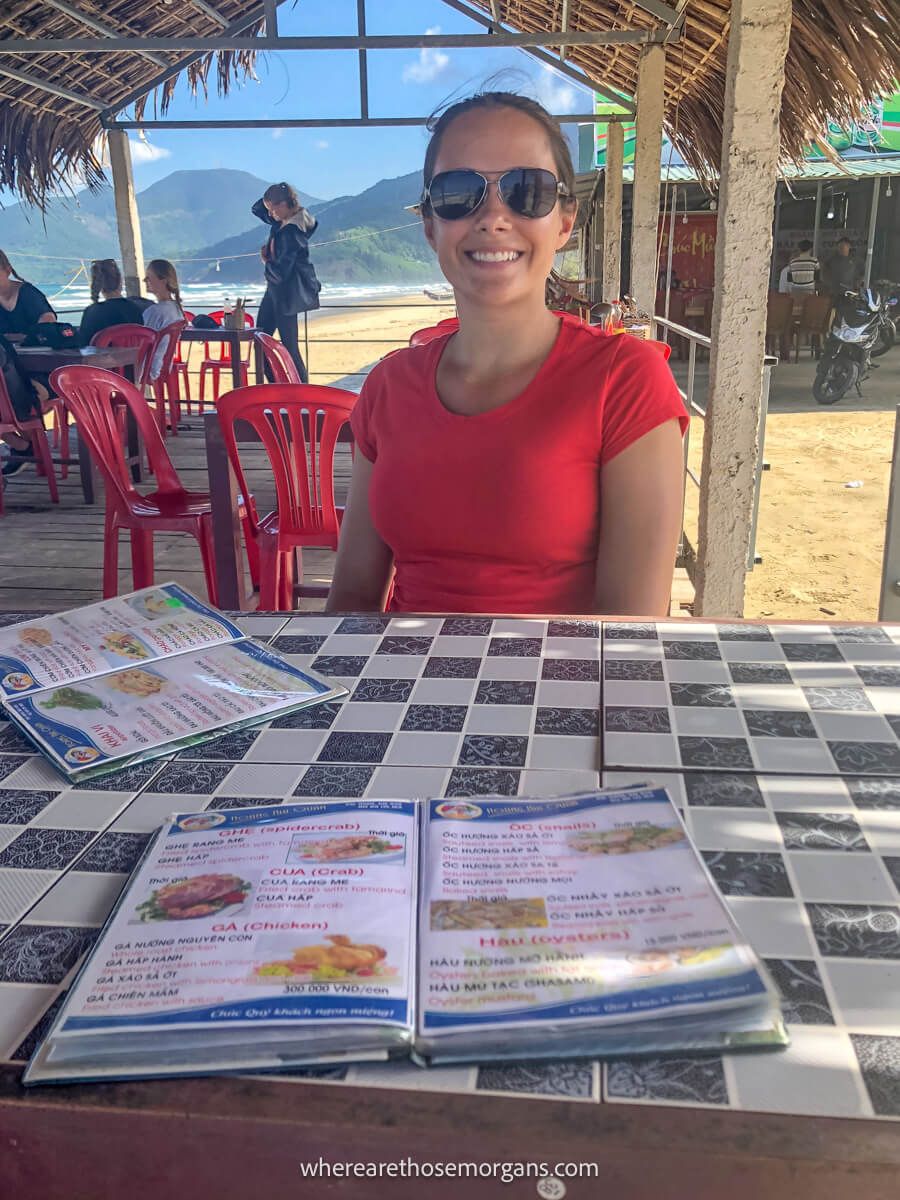
We pulled into one of the chilled out looking wooden restaurants and picked a table under cover to escape the sun for some respite. The menu looked great. We ordered rice and vegetables then sat enjoying the sound of waves crashing on the beach. The waves provided a nice change from the loud hum of the motorbike engines and traffic.
6. Dangerous Currents
But the calmness was broken up by a faraway sound, like a shriek. As we looked at other tourists on tables nearby, it seemed everyone heard something too. Then we heard the sound again, but louder this time. It was someone shouting “Help” from the sea.
Instantly all of us in the restaurant jumped up and ran to the beach. A guy on a table nearby did a David Hasselhoff, sprinted for the sea without thinking and was on his merry way out to sea. However, what he didn’t realize was that he was swimming into the same strong rip current other guy was already stuck in.
Unfortunately, Mark had experience from when he got stuck in a rip current in Thailand a few years prior to this incident. He knew the best thing you can do in this situation was to swim parallel to the beach because you’ll eventually swim out of it.
So we quickly analyzed the beach, wave direction and estimated the edge of the current. We instructed other tourists and restaurant workers to gesture frantically to the left. As both men were now stuck in the rip current and the only chance they had was to swim out of it.
Eventually, the first guy made his way left and finally back to the beach. He was exhausted and really shaken up. Hasselhoff followed a few minutes later in better shape but still extremely tired. Our blood pressure dropped dramatically as both men made it out of the water safely. Both men thanked everyone and said they genuinely thought they were going to die. Everyone involved was relieved the situation had not turned out much worse.
Travel Tip: If you plan to swim at any of the beaches along your Hai Van Pass motorbike tour, be very careful because rip currents are common along Vietnam’s central coast.
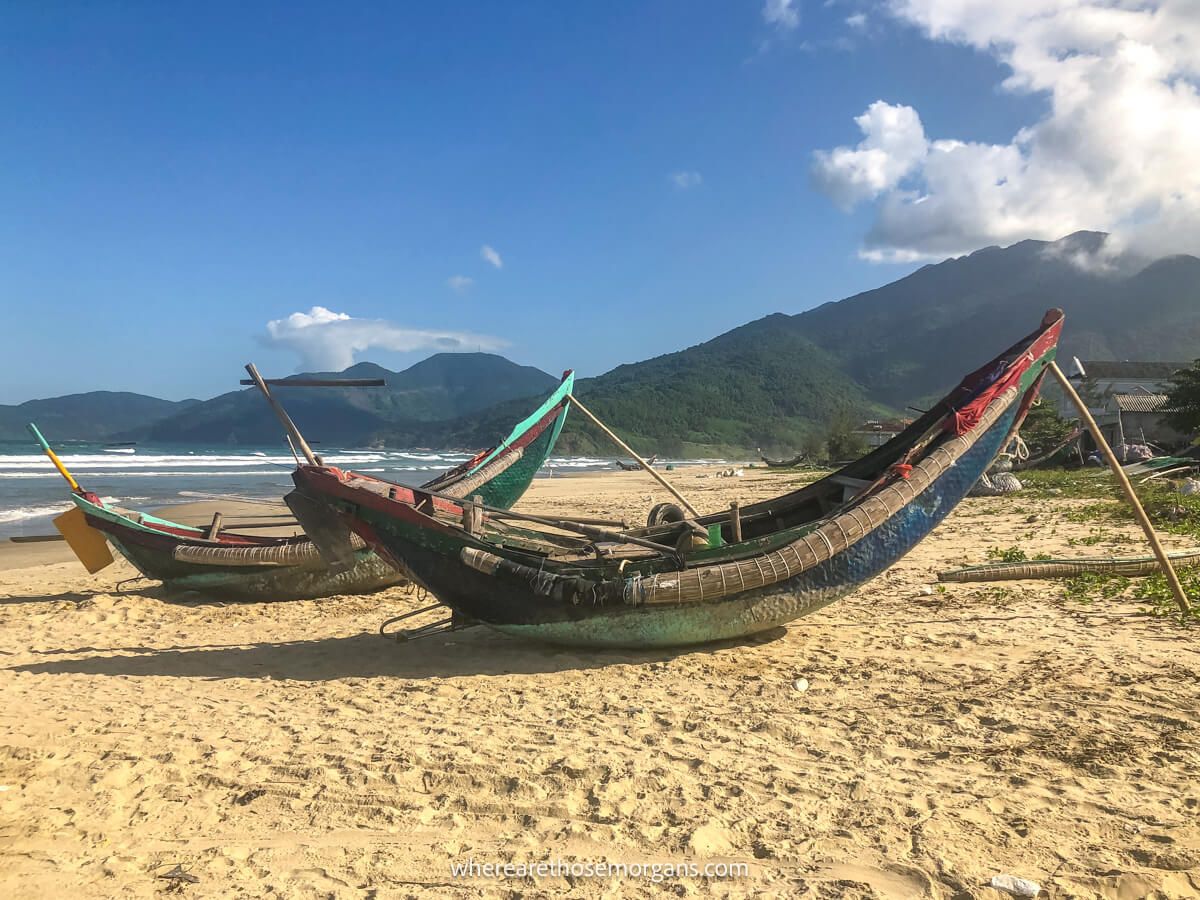
After the commotion, we ate and took a short walk along the beach. We took our shoes off and felt the sand lightly scratch our feet. It’s common to see several large boats shaped like bananas on sitting on the beach.
Getting back on our motorbikes after what we’d just witnessed felt insignificant. Once again, we made sure both men were okay now that they had some time to compose themselves. But it was time to get back on the road. We could see the Hai Van Pass towering ahead of us with thick clouds at its summit. We couldn’t wait to get up there and shake this off.
7. The Hai Van Pass Begins
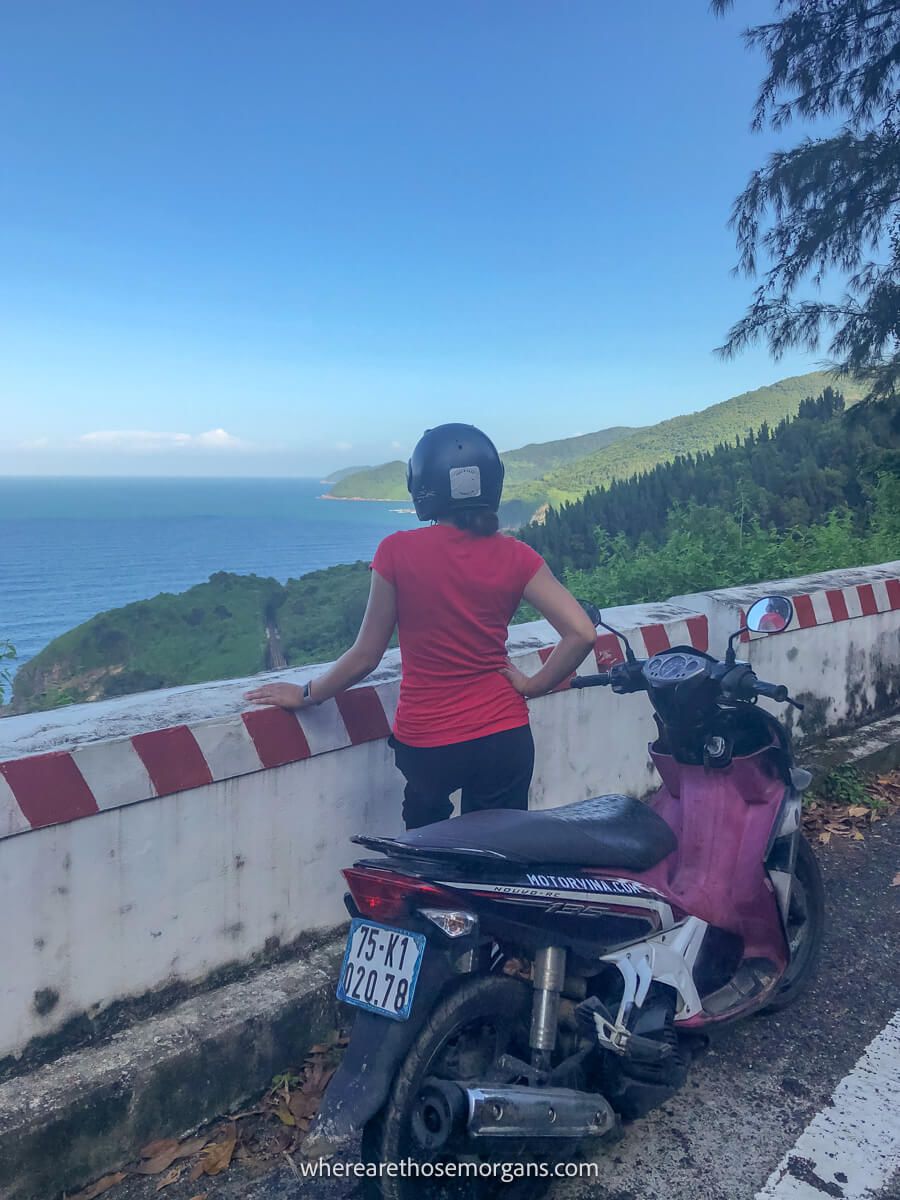
We hit the road by crossing gorgeous Cau Lang Co Bridge over the lagoon. But we didn’t fully appreciate the beauty of the view until we were further around the headland looking back at the scene. If you’re exceptionally lucky, you might see a train heading for Hanoi or Ho Chi Minh City as you cross the bridge.
Instantly the roads begin to acutely curve out of sight. We were performing 270° turns to follow the correct trajectory. Now this was getting fun…
There are several hazards and obstacles to keep in mind. These hurdles come in the form of other people either driving trucks or huge buses overtaking on blind corners. We also ran into the occasional hot headed tourist trying to become the next Valentino Rossi. All we could do is drive defensively and safely without going too slow that we caused an accident.
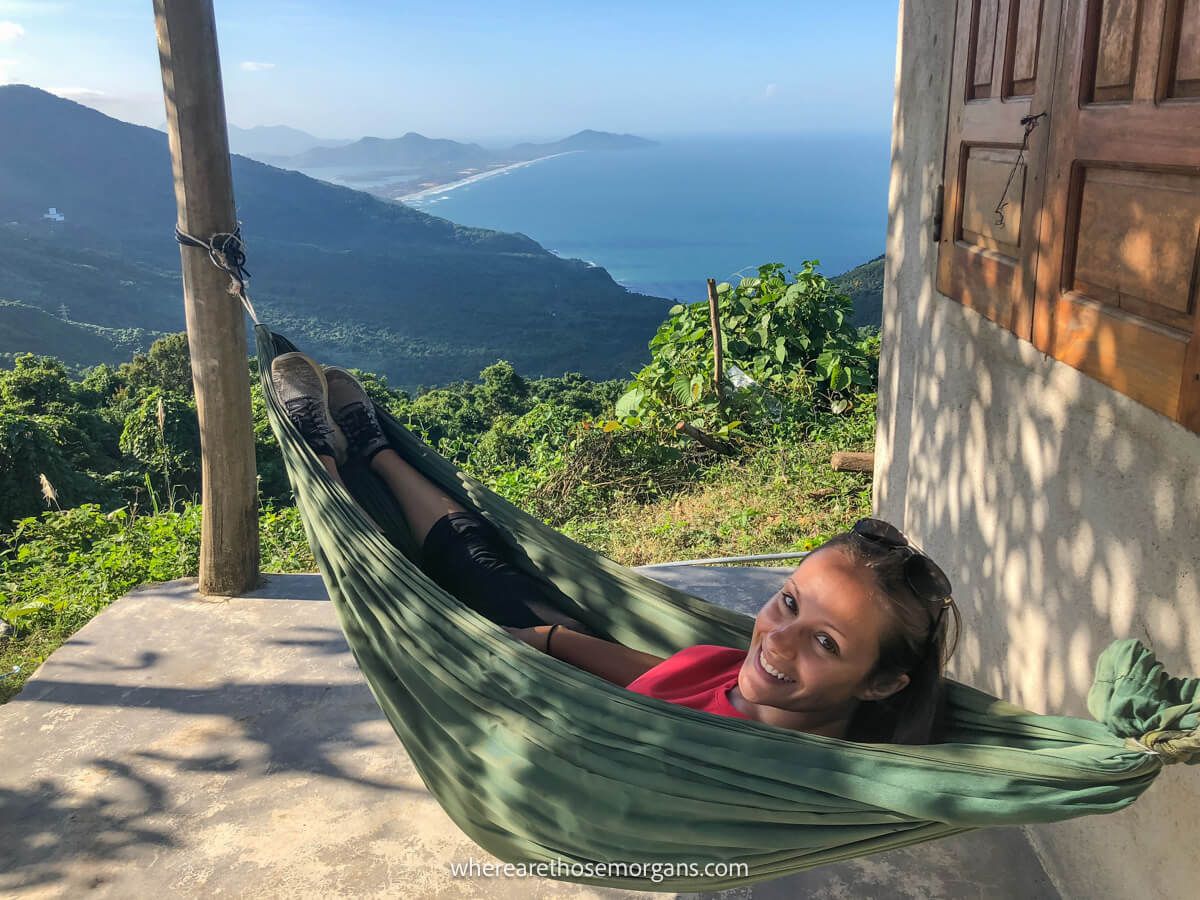
One of the stops Phu pulled over at had some hammocks where we could lounge around for a few minutes. This was definitely the best way to appreciate the spectacular view over Lang Co Bay.
8. Hai Van Pass Summit
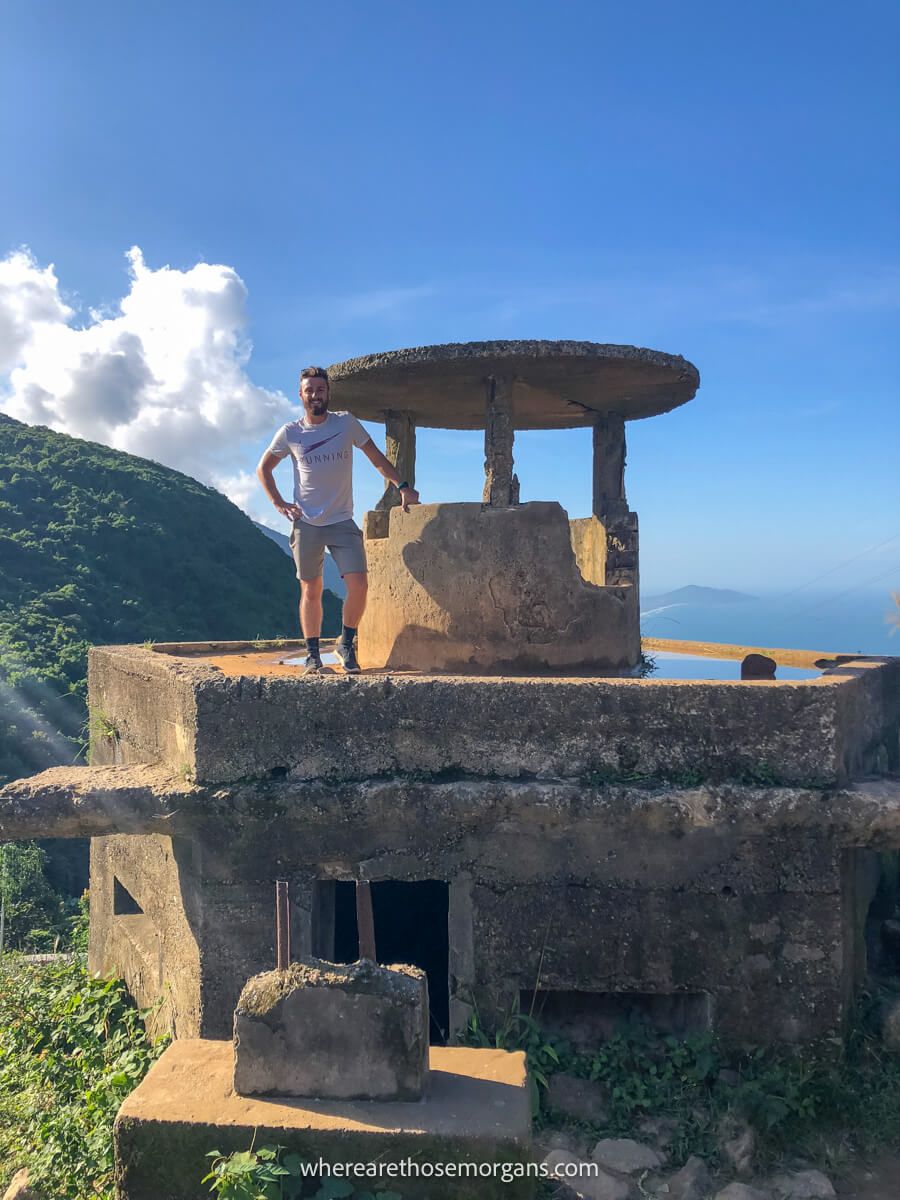
We knew we had reached the summit as we turned the last corner. There were so many buses, cars, jeeps and motorbikes parked all over the road. The Hai Van Pass is quite touristy, but we only realized this once we were at the top. Luckily, during our journey we had avoided most of the crowds.
At the summit, there are a few small places to grab some food, coffee or a beer but don’t expect much. A huge rusting old road sign is the first landmark we noticed, but further up a dirt path right off the road you can visit a few historical sites.
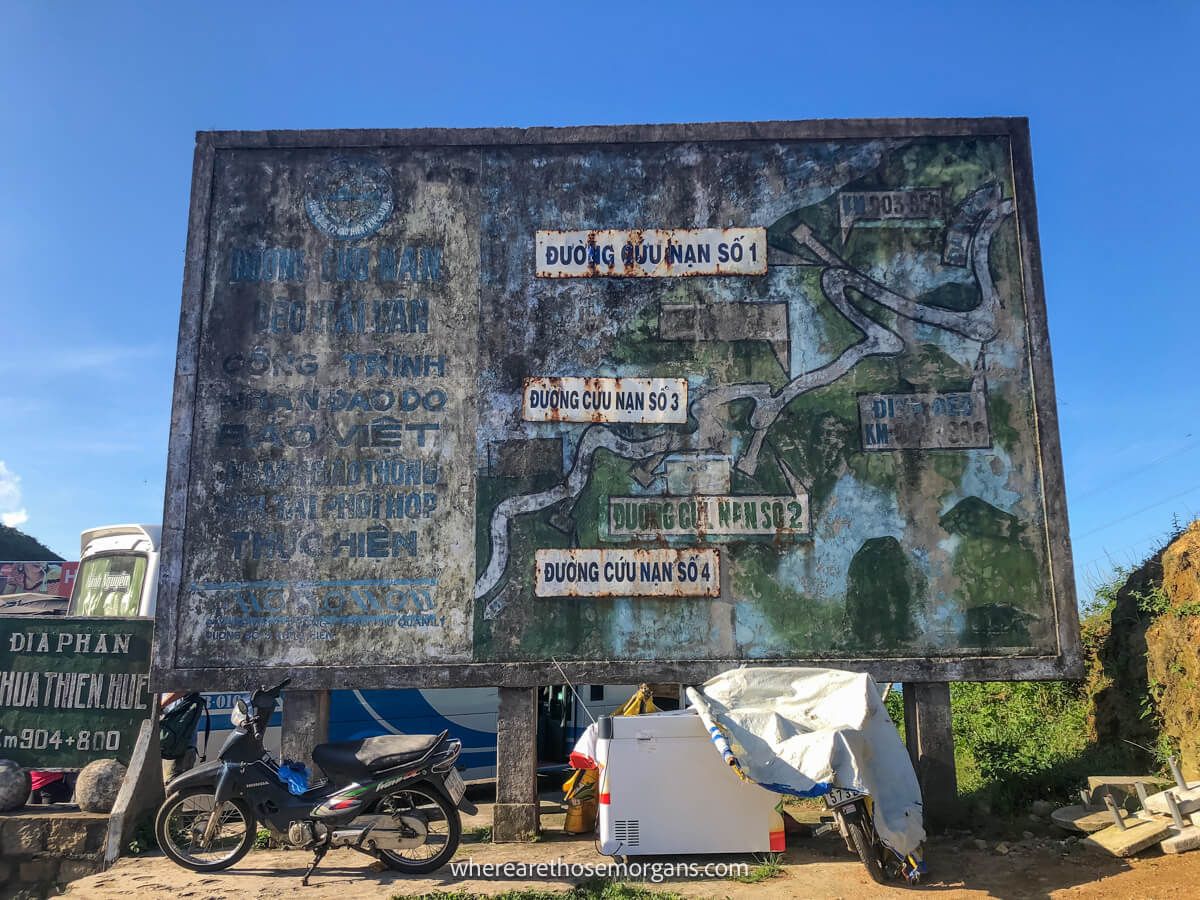
We learned the Hai Van Pass was an important defensive barrier for any army who attempted to march north or south of the pass. In 1826, a gate was built by the Nguyen Dynasty to protect Imperial City Hue. The French also built bunkers at the summit of the pass to overlook the South China Sea to the east.
These bunkers were later used by the Americans and South Vietnamese during the war and Vietcong forces would ambush the bunkers regularly. Despite the turbulent history, don’t miss the wonderful views of Lang Co Beach in the distance.
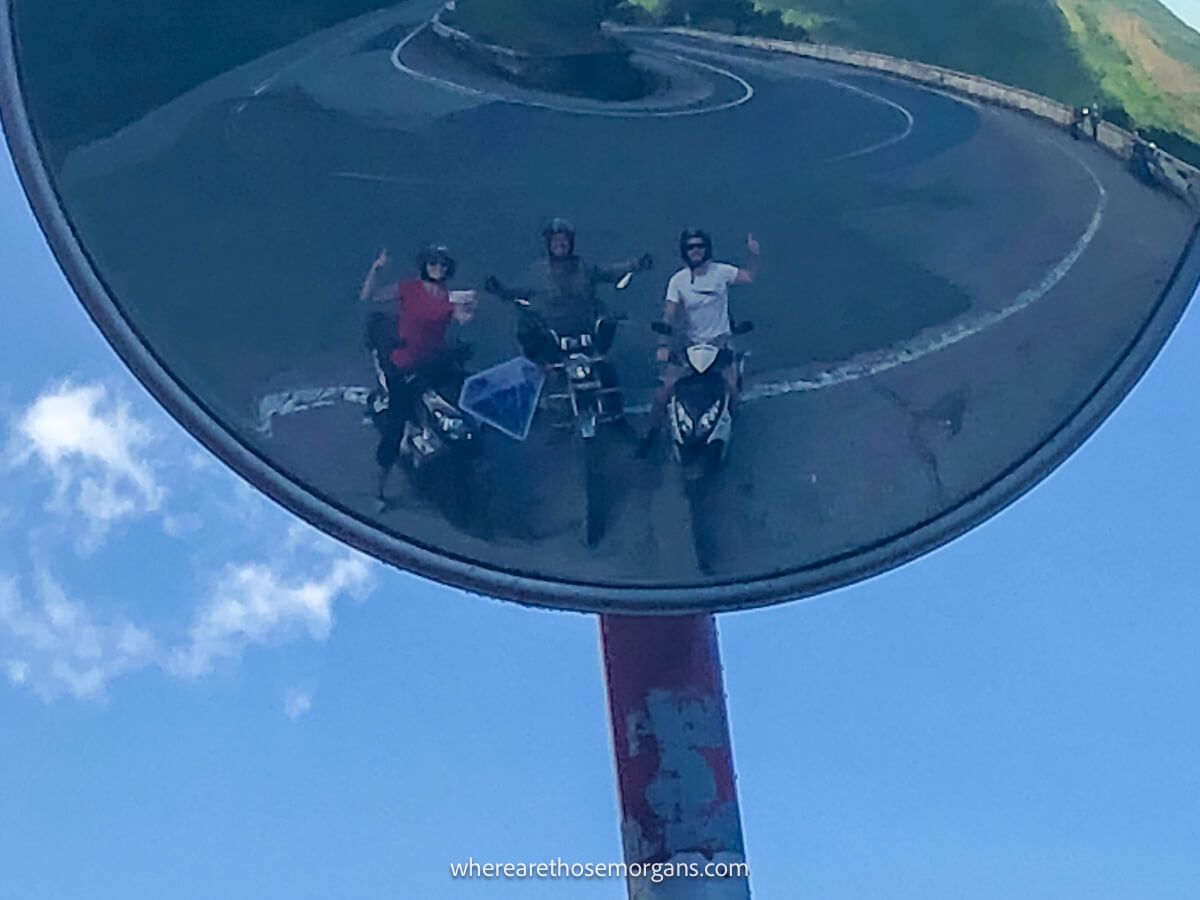
To be honest, we didn’t spend much time at the summit. It was overcrowded and apart from the historical significance, there wasn’t much else to keep us up there. Phu told us the better views of Da Nang were on the way down the other side. His tip was all we needed to get a move on.
9. Descent Into Da Nang
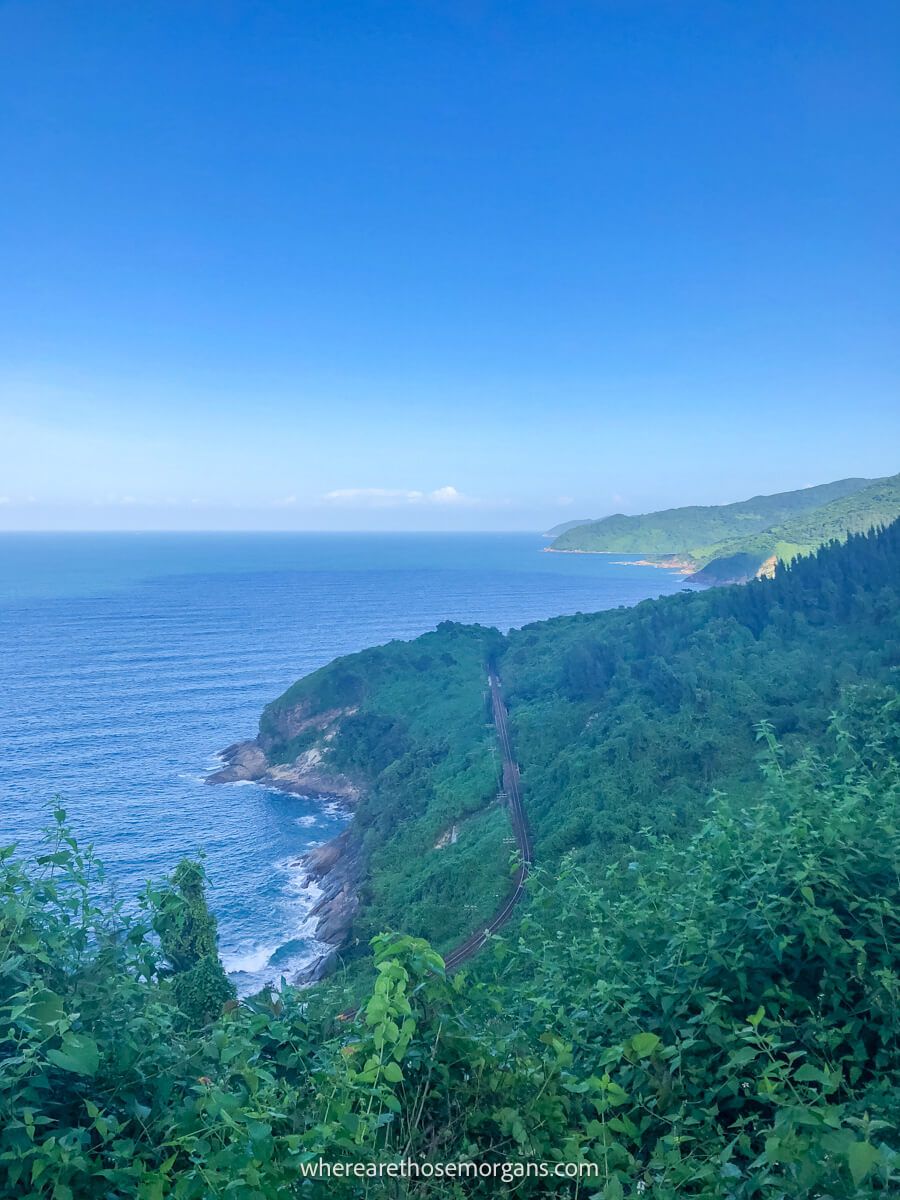
Phu was absolutely correct! The panorama over Da Nang City on the descent closely rivaled the scenes of Lang Co Beach on the other side of the pass. We thought descending the pass was much easier than ascending because gravity does all the work for you.
We stopped a few times to enjoy the cityscape view of Da Nang, its bay and the headland. It was getting late in the afternoon and the sun was heading west behind the summit so our descent was shrouded in shadow. It was bad for photos but good for shielding from the intense sun and it was a welcome change of temperature.
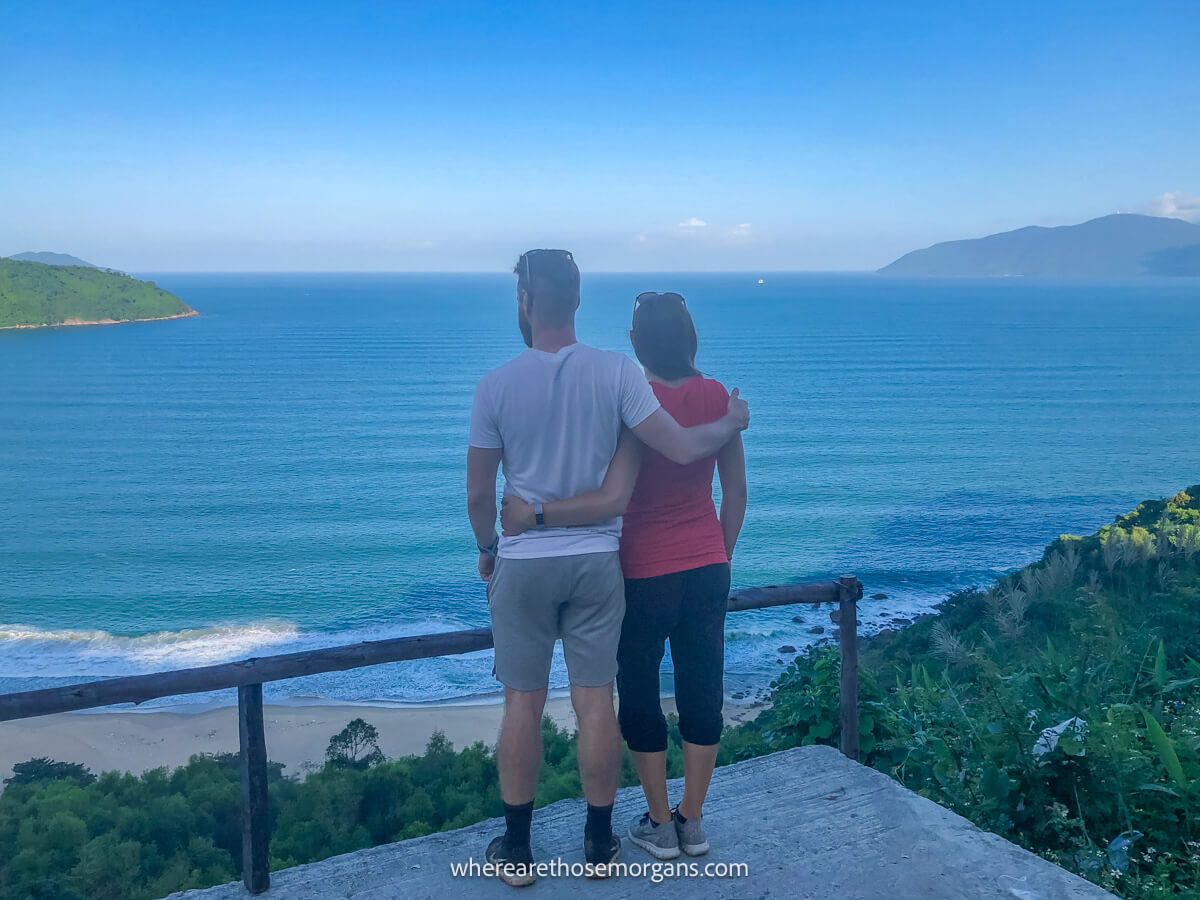
Da Nang is Vietnam’s third largest city. Unfortunately, there’s a relative amount of traffic to go along with that title. We crossed the Cau Rong Bridge with a gigantic dragon slaloming through its center and continued to Da Nang’s beachside road. The roads were packed and full with traffic so it took a long time to get to our next destination.
10. Final Stretch To Hoi An

Unfortunately, it was getting late in the day by the time we’d reached the Marble Mountains. We didn’t have enough time to hike any of the small trails which was a shame, but we still asked Phu to show us some of the marble display rooms where locals create huge sculptures.
It featured hundreds of marble statues of all shapes and sizes. He told us tourists often have them shipped to their home countries. Now we know where that statue came from in Mr. Smith’s garden…
The final stretch of road towards Hoi An was busy and natural light was failing as night approached. But Phu knew a few shortcuts on very narrow roads running between rice paddies in the countryside outside Hoi An town. He took us for a very brief stop off at a friends curated and lush green garden. Before we knew it, we had arrived in Hoi An at the office.
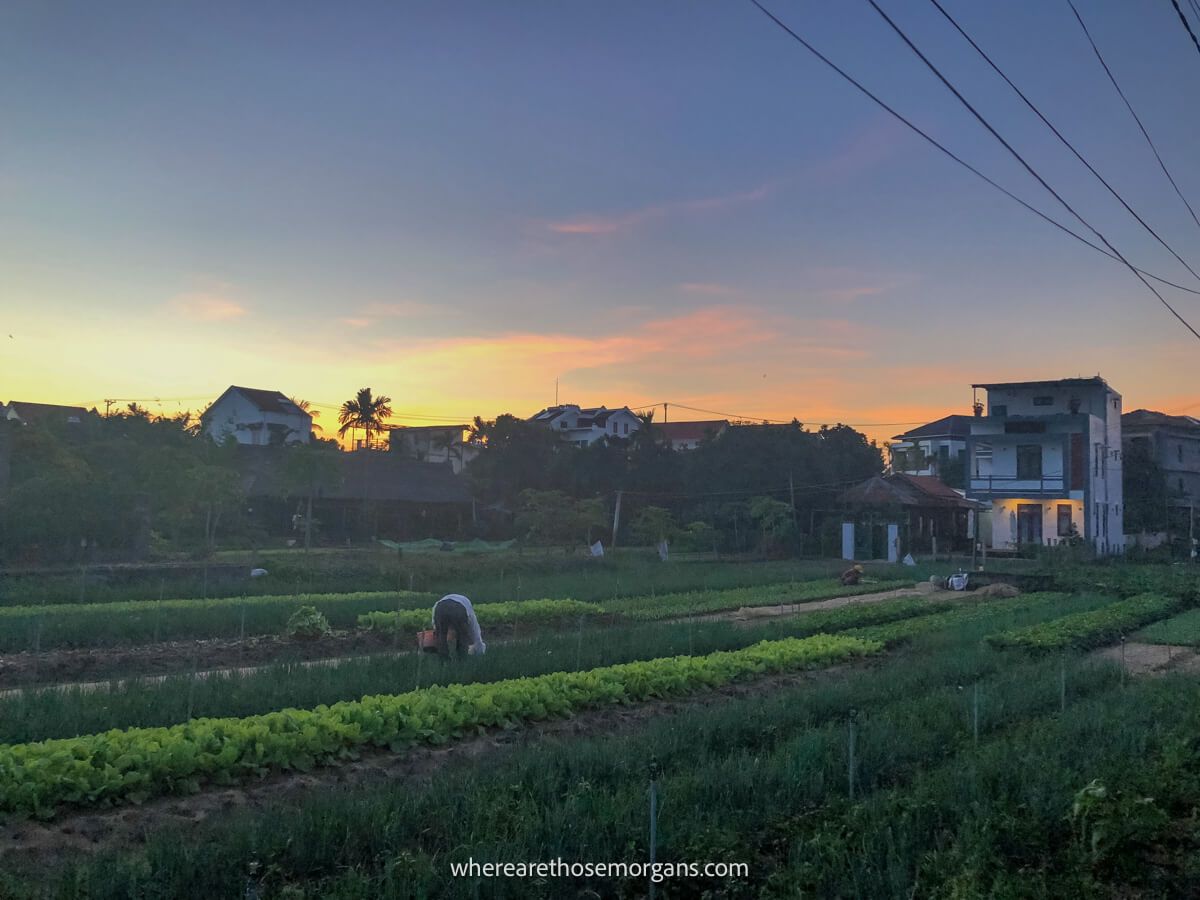
We simply signed our document to say we’d arrived and picked up our deposit. Phu had Kristen sit on his back seat and another guy from the office put Mark on the back of his motorbike as they whisked us off to our hotel in Hoi An.
We had mixed feelings as we handed our bikes in, picked up our backpacks and said goodbye to Phu. What a day. We were exhausted, but didn’t want the day to end. As the adrenaline wore off, we also quickly noticed our stiff legs and numb butts.
We had successfully conquered the Hai Van Pass by driving our own motorbikes all the way from Hue to Hoi An and had survived to tell the story. Now it was time for a celebratory beer!
The Morgan Conclusion
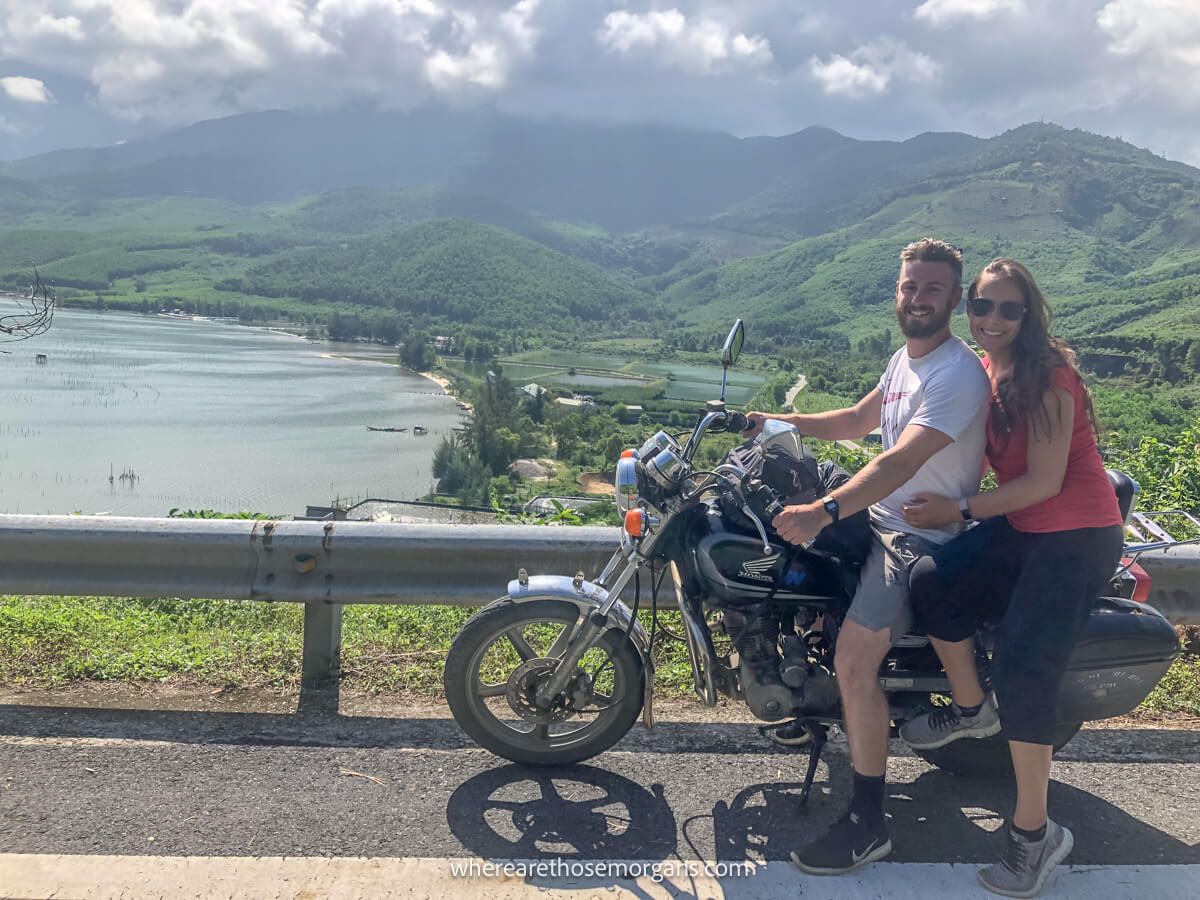
What we liked: Hiring a guide was the best decision we made because it took a lot of stress out of our trip. He helped us navigate traffic, deal with the locals so we avoided scams, knew where to stop for food and took photos of us during the trip.
What we didn’t like: Overall, the Hai Van Pass felt very touristy and it was busier than we expected. There were also a lot of fuel tankers on the road because they’re not permitted to take the tunnel and we had to watch out for very large potholes that need repairing.
Is the Hai Van Pass worth it? Yes, we think the Hai Van Pass is worth doing because it’s a once in a lifetime experience and one of the best things you can see in Vietnam. It’s a scenic drive over one of the world’s great coastal stretches with many attractions to see along the way. While you can easily drive it in a few hours, we highly recommend making a day of it so you can see as much as possible. You can drive the pass independently or book a tour depending on your comfort level.
More From Vietnam
- Best places to visit in Vietnam
- 3 week Vietnam example itinerary
- How to spend 10 days in Vietnam
- Things you need to see in Sapa
- What to expect on a Sapa trekking tour
- How to spend two days in Hanoi
- How to get from Hanoi to Halong Bay
- Tips for booking a cheap Halong Bay cruise
- Amazing things to do in Ninh Binh
- Adventurous activities in Phong Nha
- Unique experiences in Hoi An
- Visiting Hue’s abandoned water park
- What to know about Vietnam before visiting
Want more Vietnam content? Head over to our Vietnam Travel Guides to see example itineraries, tips and popular city guides.
We hope our Hai Van Pass travel guide helps you plan your trip from Hue to Hoi An!
Please let us know if you have any questions about traveling through Vietnam the comments below.
Happy Travels,
Mark and Kristen
Enjoy this guide? Pin it for later!
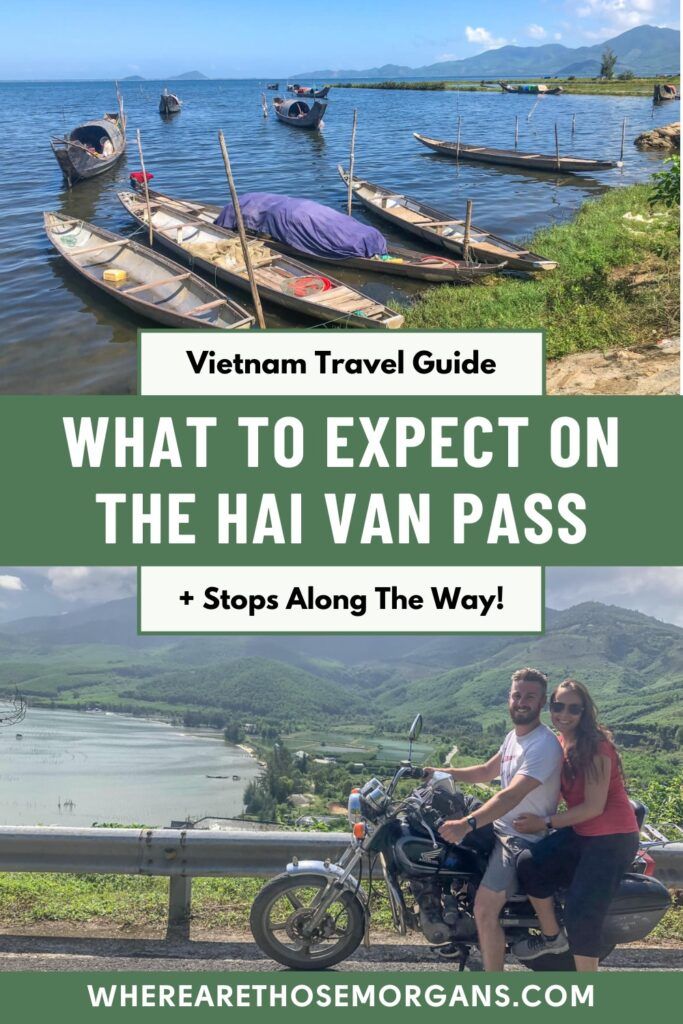
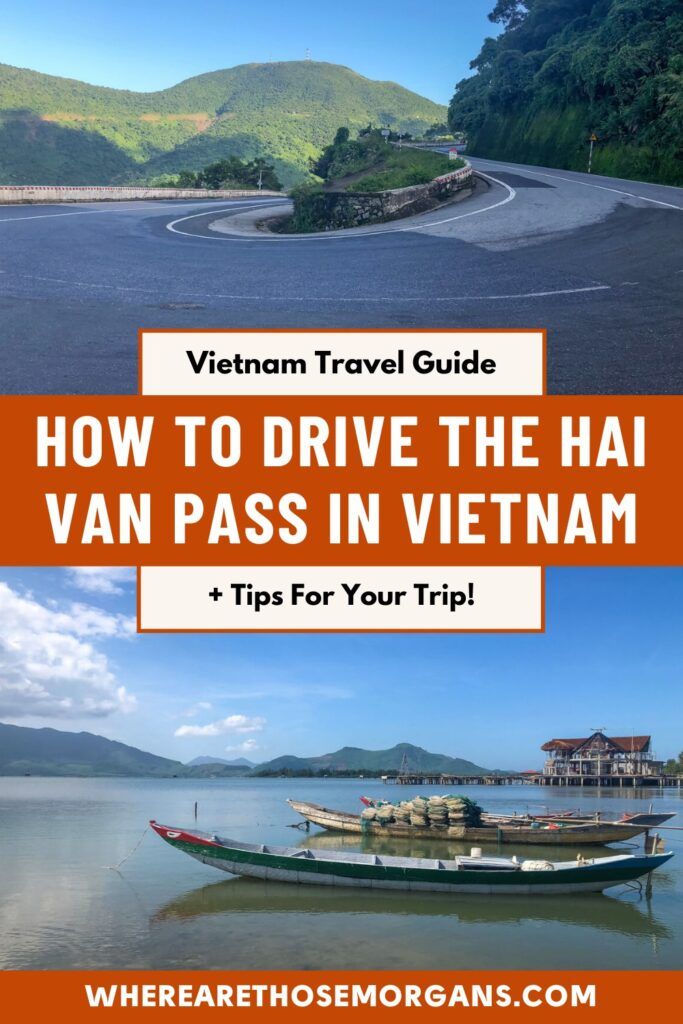
All Rights Reserved © Where Are Those Morgans, LLC. Republishing this article and/or any of its contents (text, photography, maps, graphics, etc.) in whole or in part is strictly prohibited.


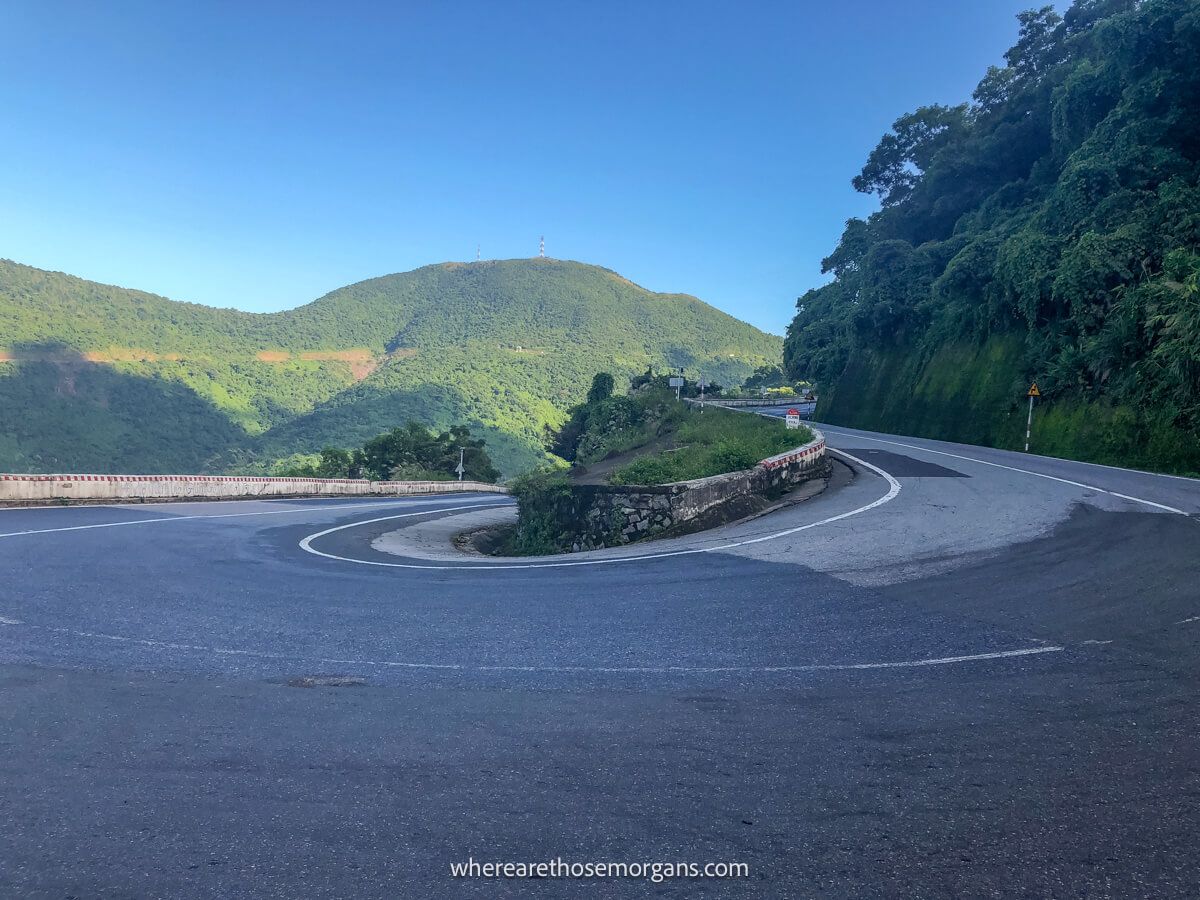
Great blog! Do you think driving this route is possible with no prior motorbike experience?
Hi Clodagh, yes it is possible with no prior motorbike experience. Kristen had no motorbike experience prior to driving this route. However, we would definitely recommend you hire a guide in that case so you can focus on your driving instead of worrying about finding the best spots along the Hai Van Pass. Enjoy the drive!